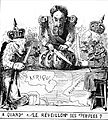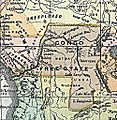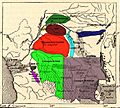Congo Free State facts for kids
Quick facts for kids
Congo Free State
État indépendant du Congo
|
|||||||||
|---|---|---|---|---|---|---|---|---|---|
| 1885–1908 | |||||||||
|
|
|||||||||
|
Motto: French: Travail et progrès
(Work and Progress) |
|||||||||
|
Anthem: "Towards the Future"
|
|||||||||
 |
|||||||||
| Status | Personal union with the Kingdom of Belgium | ||||||||
| Capital | Boma | ||||||||
| Common languages | French (de facto official), more than 200 indigenous languages |
||||||||
| Government | Absolute monarchy | ||||||||
| Ruler and owner | |||||||||
|
• 1885-1908
|
Leopold II of Belgium | ||||||||
| Governor-general | |||||||||
|
• 1885–1886
|
Francis Walter de Winton (first) | ||||||||
|
• 1900-1908
|
Théophile Wahis (last) | ||||||||
| Historical era | New Imperialism | ||||||||
| July 1 1885 | |||||||||
| November 15 1908 | |||||||||
| Currency | Congolese franc | ||||||||
| ISO 3166 code | CG | ||||||||
|
|||||||||
The Congo Free State (French: État indépendant du Congo) was a very large area in Central Africa. It was not a country in the usual sense. Instead, it was privately owned by Leopold II, who was the King of the Belgians.
Leopold II told the world he wanted to help people and explore the region. He gained support for his International African Association (French: Association internationale africaine). He formed this group at a meeting he hosted in Brussels in 1876.
The king used this association to claim most of the Congo Basin. He then created a new group called the International Association of the Congo (French: Association internationale du Congo). This group was officially recognized by many governments at the Berlin Conference of 1884-85. On May 29, 1885, King Leopold II named his new territory the Congo Free State.
Contents
What Was the Congo Free State?
The Congo Free State was a huge territory in Africa. It was about 76 times larger than Belgium itself. It was ruled by King Leopold II of Belgium. He was the only owner and ruler of this vast land.
This was unusual because most colonies were owned by governments. The Congo Free State was Leopold's personal property. He controlled everything that happened there.
How Did Leopold II Get Control?
Leopold II was very ambitious. He wanted Belgium to have colonies like other European powers. He saw the Congo region as a great opportunity.
He used explorers like Henry Morton Stanley to map the area. Stanley signed many treaties with local chiefs. These treaties often gave Leopold control over their lands.
Leopold convinced other European leaders that his goals were peaceful. He said he wanted to stop the slave trade and bring civilization. This helped him get international recognition for his claims.
The Berlin Conference's Role
The Berlin Conference (1884-1885) was a meeting of European powers. They discussed how to divide Africa among themselves. At this conference, Leopold II's claims to the Congo were officially recognized.
This recognition allowed him to establish the Congo Free State. It became his personal domain, not a Belgian colony. This was a key moment in the history of the region.
Life in the Congo Free State
Life for the people in the Congo Free State was very difficult. Leopold II's main goal was to make money. The region was rich in natural resources, especially rubber and ivory.
The demand for rubber grew very high. It was used for tires and other new products. Leopold forced the local people to collect rubber. They had to meet very strict quotas.
Forced Labor and Hardship
People were forced to work long hours. They received little or no pay. If they did not meet their quotas, they faced harsh punishments.
Villages were often raided. Families were taken hostage to ensure workers collected enough rubber. This system caused immense suffering. Many people died from overwork, hunger, and disease.
International Outcry
News of the terrible conditions slowly reached the outside world. Missionaries and journalists reported on the abuses. Roger Casement and E.D. Morel were two important figures.
They exposed the brutal system to the public. Their reports led to a huge international protest. People around the world were shocked by what was happening.
The End of the Congo Free State
The international pressure grew too strong for Leopold II to ignore. The Belgian government also faced calls to take action. They could no longer stand by while these abuses continued.
In 1908, the Belgian Parliament decided to take over the Congo Free State. They bought the territory from King Leopold II. This marked the end of his personal rule.
From Free State to Belgian Congo
The Congo Free State officially became the Belgian Congo. The Belgian government promised to improve conditions. They aimed to end the forced labor and bring better governance.
While conditions did improve, the Congo remained a colony. It was still controlled by a European power. The people of the Congo would have to wait many more decades for their independence.
Images for kids
-
Leopold II, King of the Belgians and owner of the Congo Free State from 1885 to 1908
-
Henry Morton Stanley, whose explorations helped Leopold claim the Congo region
-
Roger Casement, who reported on the abuses in the Congo
-
An equestrian statue of Leopold II in Brussels, Belgium
See also
 In Spanish: Estado Libre del Congo para niños
In Spanish: Estado Libre del Congo para niños























